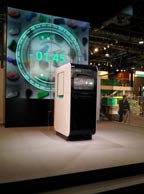
With the K2013 being the largest plastics show in the world, machine makers are there to stir up the industry. German injection moulding machine maker Arburg certainly did that! A day before the show officially opened on 15 October, journalists were given a treat preview with the flamboyant launch of Arburg’s new technology. When it was unveiled, many were wondering if it was a micromoulding machine or a printer?
Well the Freeformer, as it is known, could be a cross between a printer and a micromoulder, with its compact size. It really is an additive manufacturing machine for 3D printing that allows for small batch production using standard resins, without a mould or prototyping.
So how does it work? It produces parts layer by layer directly from 3D CAD files using drops of liquid resins. Also, unlike the usual 3D printer that uses filaments, resins in the Freeformer are first melted with a screw, similar to conventional injection moulding, and then broken down into tiny droplets in a piezoelectric system, at 100 droplets/second. With a droplet size of 0.3 mm, the entire process will take an hour to complete, Arburg officials noted.
What are the benefits? It uses standard plastics, which the firm says is “something quite new, with the price difference in a factor of a 100.” Components produced are said to boast a strength of approximately 70-80% of conventionally produced injection moulded parts. It can also be configured in either a single or two-component machine, allowing for interesting opportunities ie. hard/soft material combinations. Arburg says it has run trials with ABS, polycarbonate and elastomers with success. One limitation would be the small material dispensing nozzles that are not able to handle glass fibres or highly filled materials. But a plus point above this is that the machine could be used to produce complex parts that cannot be injection moulded or materials with a high temperature range or it could be used for faster innovations in hardware development, and the surfaces of parts produced do not require any finishing work. Furthermore, the nozzle remains stationary, while the component carrier moves along three or five axes. An advantage of this is that undercuts can be produced without the need for support structures, thus allowing a new freedom in geometry and less material wastage.
The firm has filed 20 patents and says all R&D was undertaken in-house at its facility.
Though the first Freeformer won’t be available until next year and there is no price tag yet on the machine, Arburg deserves a pat on the back for a technology that could push the limits of the plastics industry further!
(PRA)















